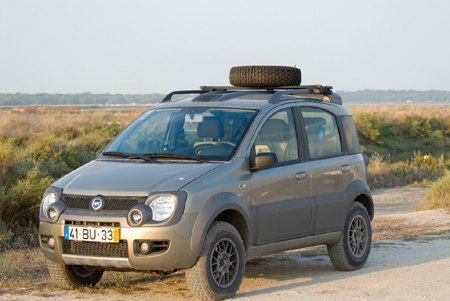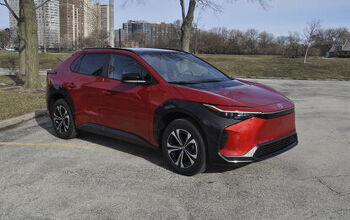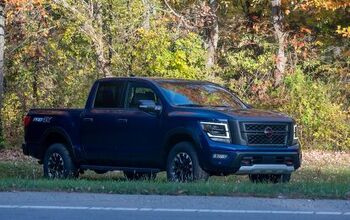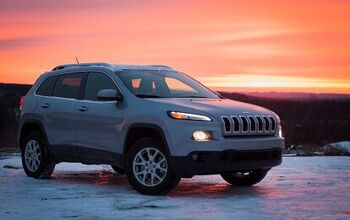Review: 2008 Fiat Panda 4X4

Guys are funny: we lust for beautiful, fast cars with which we hope to impress the neighbors, the guys, and the other sex. But memories are not made of pistonheads’ wet dreams. Looking back, the memorable machines I had were more mutt than thoroughbred: the go-anywhere, never-let-you-down, unpretty, everyday companion. Like the pickup trucks you Americans love, or the iconic 2CV, Renault R4, and VW Beetles we Europeans have in our collective memories. The Fiat Panda has always been on my short list of potential cars-as-buddies: cheap, reliable, fun to drive, unpretentious. So, I was curious: is the 4×4 version of the Panda a faithful mutt, or just another automotive dog?
The Panda looks like no other small car, because it aims to resemble a microscopic SUV (from the time when SUVs were something to emulate). It sure isn’t beautiful, but can it be called ugly? When functional things are what they pretend to be, I’d say ugly is only when the proportions are wrong, the materials are crassly cheap, or when embellishments are grotesque. So, ugly it’s not.
The 4×4 Panda has added ground clearance totaling about 11 inches; you sit high (in my case, eyes at 4ft4“). The dashboard has a pleasant, non-generic shape, the stick shift is located conveniently high, and everything looks well-made. Plastics are almost all hard, as they should be in an off-road vehicle. Headroom is gigantic; the front is a snug but airy place. Legroom in the back is OK for two slim adults, considering that this a tiny (140 inch) car.
My tester was equipped with a modern 70 hp 1.3L 16v diesel. Normally I don’t think diesels belong in a small car. Oil burners are too heavy, too loud and not really economical. But for terrain use, torque trumps all. So I was willing to reconsider. And it’s not bad. Clattery from a cold start but unloud later. The common-rail Multijet provides linear acceleration from 1,000 to 4,700 RPM and strong thrust for the all-important 45-70 mph highway spurt. Don’t ask about 0-60 please. Just trust me: you seldom feel underpowered when 70 diesel horses have only 1060KGs (1.2 US tons) to schlep. My average of 39 mpg is nothing to throw your shoes at, either.
Any vehicle that kicks me in the butt is not going to be my friend (I want a mule, not a goat!). Happily, the Panda’s ride is on the OK side of OK. It feels notchy from standstill, but, generally, the Panda is a surprisingly refined, reassuring package. Let me ask you this: what do you feel when you take a car on a spirited blast over cobblestone roads and through rocky potholes?
Does your vehicle feel fragile and uneasy or does it just shrug it off? Offroad, the Panda competes with the Range Rover. Onroad, it sports a fun and reassuring ability to take speed humps and lousy roads unperturbed. Torque steer is a non-factor, steering is lightweight and precise, and visibility is outstanding. Presto: the (for me) ideal urban car is a micro-SUV.
So there we are. The Fiat Panda 4×4 is great in the country and it’s better in town. It’s no good for high-speed, long-distance driving (too slow, too bouncy), so it’s not for me. But if I lived in one of my favorite places -– say, Zurich or Nice, or another beautiful city near the mountains – this could be one of my favorite cars.

More by Martin Schwoerer
Latest Car Reviews
Read moreLatest Product Reviews
Read moreRecent Comments
- W Conrad I'm not afraid of them, but they aren't needed for everyone or everywhere. Long haul and highway driving sure, but in the city, nope.
- Jalop1991 In a manner similar to PHEV being the correct answer, I declare RPVs to be the correct answer here.We're doing it with certain aircraft; why not with cars on the ground, using hardware and tools like Telsa's "FSD" or GM's "SuperCruise" as the base?Take the local Uber driver out of the car, and put him in a professional centralized environment from where he drives me around. The system and the individual car can have awareness as well as gates, but he's responsible for the driving.Put the tech into my car, and let me buy it as needed. I need someone else to drive me home; hit the button and voila, I've hired a driver for the moment. I don't want to drive 11 hours to my vacation spot; hire the remote pilot for that. When I get there, I have my car and he's still at his normal location, piloting cars for other people.The system would allow for driver rest period, like what's required for truckers, so I might end up with multiple people driving me to the coast. I don't care. And they don't have to be physically with me, therefore they can be way cheaper.Charge taxi-type per-mile rates. For long drives, offer per-trip rates. Offer subscriptions, including miles/hours. Whatever.(And for grins, dress the remote pilots all as Johnnie.)Start this out with big rigs. Take the trucker away from the long haul driving, and let him be there for emergencies and the short haul parts of the trip.And in a manner similar to PHEVs being discredited, I fully expect to be razzed for this brilliant idea (not unlike how Alan Kay wasn't recognized until many many years later for his Dynabook vision).
- B-BodyBuick84 Not afraid of AV's as I highly doubt they will ever be %100 viable for our roads. Stop-and-go downtown city or rush hour highway traffic? I can see that, but otherwise there's simply too many variables. Bad weather conditions, faded road lines or markings, reflective surfaces with glare, etc. There's also the issue of cultural norms. About a decade ago there was actually an online test called 'The Morality Machine' one could do online where you were in control of an AV and choose what action to take when a crash was inevitable. I think something like 2.5 million people across the world participated? For example, do you hit and most likely kill the elderly couple strolling across the crosswalk or crash the vehicle into a cement barrier and almost certainly cause the death of the vehicle occupants? What if it's a parent and child? In N. America 98% of people choose to hit the elderly couple and save themselves while in Asia, the exact opposite happened where 98% choose to hit the parent and child. Why? Cultural differences. Asia puts a lot of emphasis on respecting their elderly while N. America has a culture of 'save/ protect the children'. Are these AV's going to respect that culture? Is a VW Jetta or Buick Envision AV going to have different programming depending on whether it's sold in Canada or Taiwan? how's that going to effect legislation and legal battles when a crash inevitibly does happen? These are the true barriers to mass AV adoption, and in the 10 years since that test came out, there has been zero answers or progress on this matter. So no, I'm not afraid of AV's simply because with the exception of a few specific situations, most avenues are going to prove to be a dead-end for automakers.
- Mike Bradley Autonomous cars were developed in Silicon Valley. For new products there, the standard business plan is to put a barely-functioning product on the market right away and wait for the early-adopter customers to find the flaws. That's exactly what's happened. Detroit's plan is pretty much the opposite, but Detroit isn't developing this product. That's why dealers, for instance, haven't been trained in the cars.
- Dartman https://apnews.com/article/artificial-intelligence-fighter-jets-air-force-6a1100c96a73ca9b7f41cbd6a2753fdaAutonomous/Ai is here now. The question is implementation and acceptance.





































Comments
Join the conversation
If it came to Canada I'd buy it in a heartbeat. Had a hard time knowing this was a discussion about a car and not a politcal debate.
[...] Chrysler and perhaps every vehicle subject to the latest emissions and fuel cafe standards ? Fiat Review: 2008 Fiat Panda 4X4 | The Truth About Cars cute cars they are, but 1200 cc's and 60-70 bhp ? When everyone has one of these, I'll ride a [...]